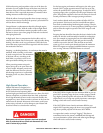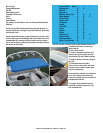
Engines should always be operated within
engine manufacturer guidelines. Failure
to do so may cause signicant damage
to the engine and drive train and is not
covered under warranty!
Elevation and weather also have a very
noticeable eect on the wide-open-throt-
tle power of an engine. Since oxygen gets
thinner as elevation increases, the engine
begins to starve for air. Humidity, baro-
metric pressure and temperature have a
noticeable eect on the density of air since
heat and humidity thin the air.
is phenomenon can become particu-
larly apparent when an engine is propped for use on a cool, dry
day in spring and then is operated on a hot, humid day in sum-
mer, and does not have the same performance. Although some
performance can be regained by dropping to a lower-pitch pro-
peller, the basic condition still exists. e propeller is too large in
diameter for the reduced power output. An experienced marine
dealer can determine how much diameter to remove from a
lower-pitch propeller for specic high-elevation locations.
MasterCra’s engine manufacturers suggest that consumers con-
sult with the dealer from whom the boat was purchased regard-
ing the best propeller for the application in which the boat will
primarily be run. However, be aware that changing the propeller
may void the warranty. Again, working with an authorized Mas-
terCra dealer is your best bet to ensure excellent performance.
Unusual Operating Conditions
If the body of water is unknown, talk to local boaters about the
type of obstacles that may be encountered beneath the water’s
surface. Rocks, tree stumps and sandbars are all dangerous and
damaging. Be especially wary of rivers and man-made lakes.
Rapidly changing conditions can cause daily changes in under-
water hazards.
Stay well clear of oating debris. What looks to be a small
branch in the water may well turn out to be an entire tree.
When traveling through weedy areas, keep an eye on the engine
temperature gauge. Weeds caught up and blocking the water
ow through the raw water intake or transmission cooler will
cause trouble. Also, aer leaving the weedy area, shi to neutral
for a few seconds and then to reverse for a few seconds to un-
wind any weeds that may have wrapped around the propeller.
Docking and Tie-Up
Approach the dock slowly, with the starboard side of the boat if
possible. e natural tendency to torque steer with the rotation
of the propeller at slow speeds makes docking easier on that side.
Also, use wind and current to your advantage when docking.
Before tying up the boat, be sure to use enough dock bumpers
to protect the boat from damage. If possible, tie-up with the
bow toward the waves. Use good quality double-braided nylon
line. Tie-up only to the liing or tie-down eyes. Never use the
handrails or ski pylon.
If the boat is to be moored for a long period of time, use chang
protectors to protect the gel coat nish. Leave a little slack in the
lines, allowing for some wave movement or tidal action where
applicable.
If the boat is to be kept in or near water for the season, consider
the purchase of a boat li and bottom paint for the hull. ese
lis prevent the build-up of marine growth on the hull as well
as protecting the boat from damage typical of on-water storage,
such as blistering. Make sure the boat li supports the hull cor-
rectly. See the next section, Liing the Boat.
NOTE: On boats that are equipped with the engine syn-
chronizing switch (models with two engines), this switch
should be disengaged during docking or when loading and
unloading the boat from a trailer. These maneuvers require
a sensitive touch and control that may not be realized when
the switch is engaged.
MasterCraft 2009 Owner’s Manual - Page 10-3


















